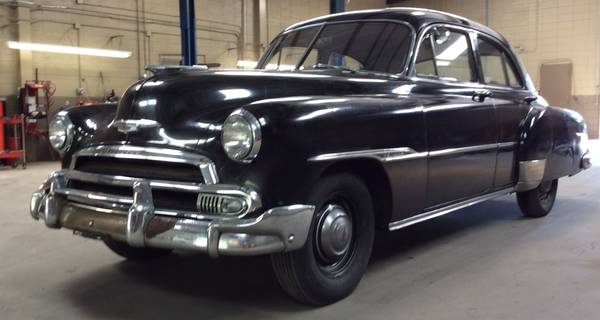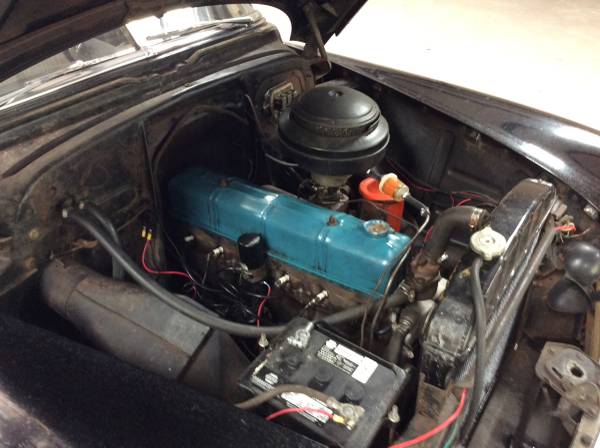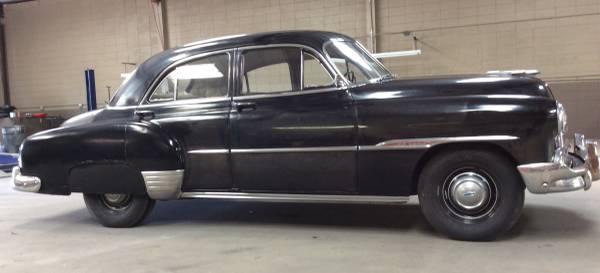This Chevy is completely original except for the mechanical work done to get it running, which included rebuilding the top end and carb and replacing the fuel lines, tank, brakes and tune up items. It’s a six cylinder automatic car. It had been parked since 2001 and shows 61,000 miles. Somebody really babied this car from new until it was parked. It even has the original pin striping on the wheels. The seller included lots of detailed photos in his ad.
How often do you see wheels from this era with the original pinstriping? The original hub caps have their original paint as well.
The front seat it tattered and needs recovering. That appears to be foam under the cover. If that’s the case, it’s already been done once. The dash appears original. The back seat and headliner look perfect, as does the floor mat.
The trunk looks very original and appears to have the original mat as well as the jack and spare wheel with pin striping. That’s not the original style tire, is it?
The engine has had some attention, but the engine compartment appears original except for the added inline fuel filter. These automatic Chevys came with the 235 CID straight six with 105 horsepower and a 2 speed powerglide transmission.
Except for surface rust, it does appear rust free. There doesn’t appear to be any oil that’s blown back from leaks.
The trim looks complete and original. This is a well sorted, smooth running old Chevy which looks much as it did in the 1950s and 1960s. It looks very much like my first car, a black Chevy like this, that cost me $65. This old Chevy is listed on craigslist in Moultrie, Georgia for $7,900. The extra doors and styling don’t appeal to all, but I think the old survivor looks pretty nice. There will no doubt be something that needs attention, but this thing looks ready to drive and enjoy. Perhaps some Coker tires in the original size and appearance might be nice. Would you want to have the bumpers rechromed? I look forward to seeing what you think of this old Chevy.










These are such great cars and really beautiful. Pricey for a 4 door but a well preserved model that probably runs great. Georgia is a no-title state for old cars and bikes, so bill of sale only on this one for sure. If only it was a fleetline.
Cool car, reminds me of my pal Dennis’s mom’s car that we got to take out from time time, circa 1965. The Powerglides were cast iron, not yet the modern version, nor was the engine. That 235 had hydraulic lifters but still didn’t have a full pressure oil system yet, but they were rugged and dependable. In ’66 classmate Curtis bought a ’49 or ’50 business coupe that had a 302 Jimmy in it (GMC inline 6), but was otherwise stock. It would snort around pretty good. Emmit’s Dad owned a stock 2 door hardtop that had a 6 and Powerglide. Nice car too. As you can tell, there were tons of those early 50’s Chevy cars around in daily service well into the 70’s. :-) Terry J
But with that early Powergiide an old lady’s car, slow off the line, top sustained speed 55 mph due to splash oil system in engine, would go up to 75 or 80 for a few minutes, but engine wear was great at speeds like that. On the other hand, for the day, it handled well, was very comfortable, front seat and back,
I believe it stated that it is a 245 cu in. If this is the case, it has an oil pump. The erlier 216 cu in, has the splash system. The 235 is a far more supior engine. Now, I could be totally incorrect, so don’t take it as gospel
In 1941, a 235.5-cubic-inch version of the 216 engine was introduced in large trucks.
This 235-cubic-inch version was added to cars in 1950 to complement the new Powerglide automatic transmission. Hydraulic lifters and a fully pressurized lubrication system was introduced in 1953, but only in cars ordered with the “Powerglide” transmission. The 216-cubic-inch continued to be standard powerplant for cars with the three-speed manual transmission until 1954, when the 235 became the standard powerplant on all Chevrolet passenger cars.
Steering wheel is not original to this car; looks like a 1953-54 version.
Pretty unusual that the passenger side of the seat upholstery is worn through to the foam vs. the driver’s side ?? Bet there’s some history there…Google “What’s eating Gilbert Grape”…
Aside that….I’d drop the rear 3″, install a set of 5 1/2″ Unity spotlights as well as matching road lights on the bumper pan and a Fulton visor. Split exhaust manifolds into straight duals, into 3” echo cans out back….Is there a better tribute to a “Chebby” ?? No Mas !!
Can You say……Pachuco ??
Few know what that means in the U.S. aside S.California.
For those who do not….Google “Pachuco Bombs”, then click on Images. There is a whole ‘nother world out there….
has an alternator. looks like my neighbors car from back in the day. they traded it for a corvair only to have the corvairs motor fall out of the car onto the street. this looks like a driver but needs to made safe first. i would leave the bumpers as is. great find.
While I’ve always been partial to the Ford Shoebox of this era, I happened to pick up an original ’49 Styleline Deluxe four years ago. The car was sold new in my hometown and I knew the entire history on it, so that’s why I bought it. Interestingly enough, I’ve started to take a liking to the old 4-door ‘jellybean’ and I’ve taken it to events all over the place. Like this example it’s quite original, only with 216/3spd. At 42K miles it’s got a lot left in it so I’ll have it for some time to come. If this unit was closer I might be tempted to investigate further as the price is pretty good. I’m not all that partial to the old Powerglides. If you don’t use them all the time, the fluid tends to seep back from the torque converter and out the breather to end up on the shop floor. And like previously mentioned, behind an old Stovebolt (more properly named Blue Flame) they aren’t the peppiest cars on the block.
Great looking old car, Chevrolet was ahead of the game on there cylinder heads and behind the eight ball on their oiling system. I have a 51 Dodge hardtop with a 218 CID flatty, as far as durability is concern I believe they were better than the stove bolt engines but less efficient with lower compression ratios and less power.The chevy’s had better styling than the Dodge with a longer sleeker stance. All that said the number of doors hung on a car seem to be the mark of value in our culture. Most of us regard a 4 door car as the the family hauler so can’t possibly be sporty or cool, but I’m here to tell you 2 door hard tops my look cool but they are a pain in the @$$ to get in and out of. The fact that we held little value for 4 door cars Caused us to scrap them at a whole sale rate, ultimately leaving the lowly 4 door like this one in short supply. This car would do well if the engine and trans were replaced with a 1960’s 250 CID inline engine with a 350 turbo hydromatic transmission transplanted into it. I’d also paint the trunk lid with a one stage paint and after it had some time to dry out I’d age it a bit with some steel wool. I’m sure the seat material could be matched up too, And I’d also age it a bit. Very cool car.
Hi Mark. I can almost agree with you on Chevy being behind the 8-ball with its oiling system but up to date with the heads. However, my ’49 had head problems and, other than dripping out of the rear seal, no bottom end–yet. Actually the head problems were a couple of burnt exhaust valves because there wasn’t quite enough attention paid to keeping the valve clearances properly adjusted and they got too tight. But for the most part, those old babbit pounders took an unbelievable amount of punishment. I think the biggest problem with them was trying to keep the bottom ends from starving when starting them up in the winter. If they were really problematic I’m pretty sure that the General would’ve stepped up Chevy’s engine development program…
2-doors vs 4-doors? Only if it was a ’69 Chevelle. I quite like my 4-door and my wife loves her ’57 Poncho 4-door. Go to an event and you can put a lot of stuff into that back seat and it’s easy to retrieve. We’re not alone with that attitude; we went to an antique auto meet up in Pincher Creek, AB, last summer and I’m sure that the majority of cars there were 4-doors. Even our friends from Conrad, MT, brought their ’64 Falcon 4-door to that event. If they didn’t bring that they’d have brought their ’37 Ford–4-door…
A 250/THM 350 would be a sensible change under the hood, provided you plan to drive it a lot. For me at 2K miles a year, I’m going to stay with the old Stovey/3 speed combo. If I had this car, I’d keep what’s there; just slide a pan underneath.
Hi Geomech after reading your post you have convinced me that this car should be left as is.you and the guys in the following posts bring up some valid points. I guess one of my biases is from a 1948 chev I bought years ago that basically had the bottom end totaled from winter starts in cold old Canada while the rest of the engine was in serviceable condition. As for the 2 speed power glide I never doubted its durability, my concern was the high start ratio and the under powered stovebolt would lead to quite sluggish driver. If this car was mine I would want to be driving as much as I could in the short season that we get. And I thought that the 250 engine with the 350 trans would make a practical combo while still looking close to what was in the car. The other thing that I would probably do is put the old stove bolt on a running stand for display purposes. Finally I’m of the school of thought that if your going to make changes like this it needs to be done in such a way that it can be reversed at a later date, and all original parts are retained. I love these old post war era cars and the history that surrounds them. With my 1951 dodge Mayfair I have done some changes such as nicer seats out of a newer car, but I still have the originals bagged an stored in the basement of my home. Cheers.
Nice car, worthy of a crate big block 502, just for FUN. :-)
For everyone lamenting powerglides, I had a friend that built a 300hp 283 and bolted it to a 1962 cast iron powerglide in his 62 SS Impala that hauled ass and
was by no means slow off the line, or at powerband. Furthermore, he beat on that glide extremely hard and it never said peep. The last time I saw that 62 Impala we decided to roast the back tires off in a parking lot at our old music studio [we had R&R band] for something to do. Just as we retired back into the studio the local constabulary showed and said they got a complaint about a car doing smokey burnouts in the parking lot. My buddy said he was not aware of any cars doing burnouts in the parking lot while the police were staring at clearly visible patches
on the asphalt. Then the police walked over to the 62 Impala and one put his hand on top of the car hood to see if it was hot while the other started asking him why the rear tires were all melted off the back rims? I forget how he got out of it, but it sure was a fun day. Guaranteed that old cast iron powerglide is still working today because as far as I am concerned you cannot kill a cast iron powerglide.
Bob
The reason Powerglides were thought to be “slow off the line” was simple gearing. 1st gear was 1.76 to 1, whereas the Turbo 350 (and most 3 speed automatics) 1st gear was around 2.5. Big difference. But the Powerglide was very efficient only needing about 24 horsepower to run, whereas the big Turbo 400 & Ford C6 require 57 h.p. or thereabouts. If you have enough torque, or your car is light enough, or has low enough gears to compensate for the high first gear, then the Powerglides deficiency is neutralized. That’s why drag racers liked them. Still do actually. :-) Terry J
I’m of the opinion that cast iron glides like drag racers too, Terry.
A match made in GM heaven, methinks.
cheers, eh. :)
Bob
The 1950-52 Powerglides did not shift when placed in Drive. In Drive, it started in high and remained there. That would be a good reason for slow starts. You could place the shifter in low for faster starts, but that was hard on the transmission. 53 and later models did shift low-high. I wonder if the earlier Powerglides can be modified?
Sweet survivor.
Had many old Chevy 6s through the years. Those old 235s would wear out pretty quickly. But once they were worn out, they’d last forever. :-) Terry J
So it must still have the original battery too. Amazing!
I’m an old friend of the owner who sold the ’51 to the guy now trying to “flip” said car. My friend only parked the Chev because the old Powergide had starting leaking at an alarming rate & had no means or funds to address the problem right away. Obviously, he parked it. After a few years he had no choice but to sell his beloved Chev in which he & I had driven many a fun miles. Unfortunately, he passed on last summer. If I had room & $$$…..well, I’d snatch the car up in an instant!!